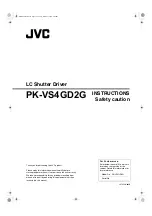
5.12 Motor Stopping Methods for Servo OFF and Alarms
5-37
5
Basic Functions That Requir
e Setting befor
e Operation
5.12
Motor Stopping Methods for Servo OFF and Alarms
You can use the following methods to stop the Servomotor when the servo is turned OFF or an
alarm occurs.
There are the following four stopping methods.
There are the following three conditions after stopping.
Motor Stopping Method
Meaning
Stopping by Applying the
Dynamic Brake
The electric circuits are internally connected to stop the Servomotor quickly.
Coasting to a Stop
The motor stops naturally due to friction during operation.
Zero Clamping
The speed reference is set to 0 to stop the Servomotor quickly.
Decelerating to a Stop
Emergency stop torque is used to decelerate the motor to a stop.
Status after Stopping
Meaning
Dynamic Brake Applied
The electric circuits are internally connected to hold the Servomotor.
Coasting
The SERVOPACK does not control the Servomotor. (The machine will move in
response to a force from the load.)
Zero Clamping
A position loop is created and the Servomotor remains stopped at a position
reference of 0. (The current stop position is held.)
•
The dynamic brake is used for emergency stops. The dynamic brake circuit will operate fre-
quently if the power supply is turned ON and OFF or the servo is turned ON and OFF while a
reference input is applied to start and stop the Servomotor. This may result in deterioration of
the internal elements in the SERVOPACK. Use speed input references or position references to
start and stop the Servomotor.
•
If you turn OFF the main circuit power supply or control power supply during operation before
you turn OFF the servo, the Servomotor stopping method depends on the SERVOPACK model
as shown in the following table.
Note: The SGD7S-210D, -260D, -280D, and -370D do not have a built-in dynamic brake. They
will always coast to a stop.
•
To minimize the coasting distance of the Servomotor to come to a stop when an alarm occurs,
zero-speed stopping is the default method for alarms to which it is applicable. However,
depending on the application, stopping with the dynamic brake may be more suitable than
zero-speed stopping.
For example, when coupling two shafts (twin-drive operation), machine damage may occur if a
zero-speed stopping alarm occurs for one of the coupled shafts and the other shaft stops with
a dynamic brake. In such cases, change the stopping method to the dynamic brake.
Important
Condition
Servomotor Stopping Method
SGD7S-1R9D, -3R5D, -5R4D, -8R4D, -120D, or -170D
Built-in or External Dynamic Brake Resistor
Not connected
Connected
Main circuit power supply
turned OFF before turning
OFF the servo
Coasting to a stop
Stopping with the dynamic brake
Control power supply
turned OFF before turning
OFF the servo
















































